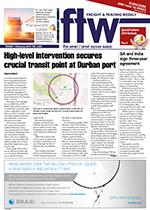South Africa is bracing for a massive uptick in grain imports as drought conditions worsen in the country’s main production regions. Traders have already begun to import maize, mainly from South America (Brazil and Argentina), as local producers face a grain harvest shortfall. “In 2016, around 3 million tonnes of grain had to be imported due to the drought and we anticipate this could be the case again,” said Grain SA CEO, Jannie de Villiers. He told FTW that the government satellites would be able to confirm this week the overall outlook for grain crops, although he wasn’t optimistic since the rainfall had come too late for planting. “Farmers try to plant in November/ December to prevent frost in April/ May, but the rainfall only came briefly around the end of December,” said De Villiers. He added that the current drought situation was “far worse” than the one experienced in 2016 as farmers had incurred “massive debt” while dealing with drought conditions three years ago. “There have of course been two strong crops since then but the commodity prices were low which leaves them unable to pay those debts,” explained De Villiers, pointing out that farmers therefore had depleted financial reserves and no longer had the ability to obtain the necessary credit required to continue farming. Having to import grain again raises the question of whether the ports could take the strain and effectively manage the additional flow of grain, having experienced a few challenges in 2016. Transnet Port Terminals Agricultural Bulk operations offers four million tons of annual capacity across its seven local ports, according to the Transnet website. And while South Africa may need to import only three million tonnes, the landlocked neighbouring countries like Zimbabwe will also import their grain through South African ports. De Villiers said that while there had been problems in 2016, certain problem areas had been addressed by 2017. “There have been lessons learnt,” he said, but exports out of the port were always easier to deal with than imports. “It’s more complicated when you offload a product from a ship as checks and paperwork can cause numerous delays,” he said. A deeper draught at the grain elevator at the port of Durban would also be advantageous as loading larger ships had a price advantage. According to De Villiers, there are plans to deepen the draught but only in four years’ time. He said loading one larger vessel could save at least one US dollar per tonne of maize. Industry lobby body AgriSA has also noted “the dire situation” of the drought and, amongst other measures, has established a drought relief fund to assist producers.
CAPTION
In 2016, around 3 million tonnes of grain had to be imported due to the drought and we anticipate this could be the case again. – Jannie De Villiers

